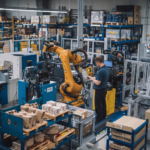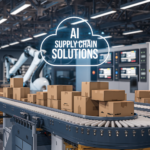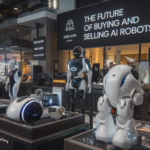The Intersection of AI and the Darknet: Unseen Risks and Emerging Solutions
Artificial Intelligence (AI) has revolutionized industries from healthcare to finance, bringing efficiency and innovation to countless domains. However, the rise of AI has also opened the door for new and darker possibilities, especially when combined with the shadowy underworld of the darknet. The darknet, a part of the internet not indexed by traditional search engines, is notorious for illicit activities ranging from drug trafficking to illegal arms sales. Now, as AI becomes more advanced, the fusion of these technologies with the darknet poses unprecedented challenges to law enforcement, cybersecurity, and society at large.
Can AI Help to Dismantle the Darknet?
AI holds tremendous potential not only in revolutionizing industries but also in fighting the darker side of the internet, including the notorious darknet. The darknet operates as a hidden network where illegal activities such as drug trafficking, human trafficking, arms sales, and cybercrime flourish, all hidden behind layers of encryption and anonymity. As law enforcement struggles to keep up with the sophistication of these illicit operations, AI is emerging as a powerful ally in the battle against the darknet.
How AI Is Changing the Darknet
While AI is typically associated with positive advancements, in the wrong hands, it can become a tool for exploitation. On the darknet, AI can be used in various troubling ways:
- Automation of Cybercrime: AI-powered malware and bots can now autonomously attack systems, finding vulnerabilities faster than any human hacker could. This has led to a surge in ransomware attacks, with algorithms quickly encrypting files and demanding cryptocurrency as ransom payments.
- Deepfakes and Digital Deception: AI has enabled the creation of realistic deepfake videos and images, which can be used for blackmail, misinformation campaigns, and identity theft. These deepfakes are often traded or sold on darknet markets, providing criminals with powerful tools for deception.
- AI-Enhanced Drug Production: AI’s ability to rapidly model chemical reactions and predict new molecular structures has extended to the illegal drug trade. Criminals are using AI to design novel synthetic drugs that evade existing regulations. This makes it harder for law enforcement and regulatory bodies to keep up with the flood of new substances being sold on darknet markets.
- Evasive Techniques: AI can be used to create more sophisticated encryption and anonymization tools, allowing darknet users to hide their activities even better. AI-enhanced proxy networks and encryption algorithms make it harder for authorities to trace illegal activities back to their source.
AI as a Double-Edged Sword
While AI has empowered criminals on the darknet, it has also equipped law enforcement with new tools to combat these threats:
- AI for Darknet Monitoring: AI-based systems can sift through massive amounts of data to identify patterns and anomalies in darknet transactions. Machine learning algorithms are being used to predict criminal activity, flag suspicious behavior, and trace cryptocurrency transactions to uncover the identities of illicit actors.
- Image Recognition and Deepfakes Detection: Advanced AI models are helping authorities detect deepfakes, identifying subtle inconsistencies that betray synthetic images and videos. This technology is crucial in countering the growing misuse of deepfakes for fraud and blackmail.
- Predictive Policing: By analyzing trends in cybercrime, AI systems can help predict and prevent criminal activity before it happens. This includes the identification of vulnerable systems that may be targeted and the interception of emerging drug markets on the darknet.
Ethical and Legal Implications
The intersection of AI and the darknet raises significant ethical and legal questions. AI technologies, by their nature, are neutral; their impact depends on how they are used. This duality creates challenges for governments and regulators who must balance innovation with security.
- Privacy vs. Surveillance: As AI becomes more prevalent in monitoring the darknet, privacy concerns arise. How much surveillance is acceptable in the name of security, and where is the line between protecting society and infringing on individual rights?
- Regulation of AI: Governments are grappling with the need to regulate AI technologies without stifling innovation. However, as AI becomes a tool for crime, stronger regulations around its development and use, especially in sensitive domains like deepfake technology and autonomous systems, may become necessary.
- International Collaboration: The darknet is a global phenomenon, and so is AI. Tackling the intersection of AI and the darknet requires international cooperation among governments, tech companies, and law enforcement agencies to create standardized approaches to cybersecurity and crime prevention.
Future Outlook
The convergence of AI and the darknet is a relatively new but rapidly evolving threat. As AI continues to develop, its misuse on the darknet will likely grow in sophistication. However, this same technology also holds the key to combating these dangers.
The future will require a delicate balance between leveraging AI for security and ensuring that it doesn’t become an uncontrollable force that outpaces our ability to regulate and mitigate its harms. Collaborative efforts between the private sector, governments, and international organizations will be crucial in addressing these challenges and ensuring that AI’s potential is harnessed for good rather than exploited for nefarious purposes on the darknet.
In this age of digital transformation, AI’s role in shaping both the surface web and the darknet cannot be underestimated. The question remains: Will we be able to stay ahead of the curve, or will AI-powered criminal networks become the new norm in the underbelly of the internet? Only time will tell.
Darknet Monitoring and Intelligence Gathering
AI can play a crucial role in real-time monitoring of darknet forums, marketplaces, and transactions. By deploying machine learning algorithms, authorities can sift through vast amounts of data on the darknet that would be impossible for humans to analyze manually. AI can identify patterns, trends, and key indicators that may reveal illegal activities or uncover the identities of criminal actors.
For example, AI-powered tools can analyze language patterns in chat rooms or forums, detect suspicious transactions using cryptocurrencies like Bitcoin, and flag attempts to sell illegal goods or services. In many cases, AI can predict illicit behavior before it occurs, enabling proactive rather than reactive measures.
Tracking Cryptocurrency Transactions
One of the primary ways darknet users conduct transactions is through cryptocurrencies, due to the anonymity they offer. However, AI is making it harder to hide such transactions. Blockchain analysis tools, powered by AI, can track and analyze cryptocurrency movements across public ledgers, identifying suspicious activity or patterns consistent with money laundering or criminal behavior.
While blockchain technology provides anonymity, it is not completely untraceable. AI can link seemingly unrelated transactions and wallets together by spotting patterns that human analysts might overlook, leading to the identification of darknet users or criminal syndicates.
Combatting Cybercrime with Predictive Analytics
AI can use predictive analytics to anticipate cyberattacks or criminal activity on the darknet. Machine learning algorithms analyze historical data on cyberattacks, malware, and ransomware, identifying precursors to future events. This allows law enforcement agencies and cybersecurity experts to harden vulnerable systems, disrupt attacks before they occur, and even trace the source of the malware.
In some cases, AI-based tools can predict which darknet marketplaces or forums are likely to host illegal activities, allowing authorities to focus their efforts on dismantling key areas of criminal operations.
Detecting Deepfakes and Illicit Content
AI has made it easier to create highly realistic deepfake videos and images, which are often used for blackmail or the spread of misinformation on the darknet. However, AI can also be used to detect these synthetic images by identifying inconsistencies in facial movements, shadows, or pixels that human eyes may miss.
Furthermore, AI can be trained to detect other forms of illicit content circulating on the darknet, such as child exploitation materials or counterfeit documents. By scanning and analyzing media, AI helps law enforcement agencies quickly identify and remove such harmful content from circulation.
Collaborative AI Networks for Law Enforcement
One of the biggest challenges in fighting darknet activity is the decentralized nature of both AI and darknet crime. However, AI can be used to bridge the gap by enabling better collaboration between international law enforcement agencies.
AI systems can share real-time intelligence across borders, allowing different agencies to coordinate their actions against global darknet syndicates. For example, if AI detects a pattern of activity in one country, it can alert authorities in another region where the same behavior is starting to emerge, facilitating a global response to darknet crime.
Challenges of Using AI Against the Darknet
While AI presents promising solutions for rejecting the darknet, it is not without its challenges. Criminals are also using AI to enhance encryption and evade detection, which means there is an ongoing race between law enforcement and cybercriminals. Additionally, AI systems require vast amounts of data, and working with anonymized data from the darknet can lead to limitations in how effectively AI can operate.
Ethical concerns also arise, particularly around the potential for surveillance and invasion of privacy. As AI increasingly monitors dark spaces of the internet, a balance must be struck to ensure it does not infringe on legitimate privacy rights or freedoms.
The Future of AI in the Battle Against the Darknet
AI’s role in dismantling the darknet is still in its early stages, but the results so far are promising. As AI technology advances, its potential to counteract darknet activities will likely expand, giving law enforcement a critical edge in this ongoing battle. However, success will depend on continuous innovation and collaboration between government agencies, tech companies, and global organizations.
By enhancing our ability to monitor, track, and predict darknet activity, AI could eventually lead to a significant reduction in the illegal operations that thrive in the internet’s shadows. While the darknet will likely always exist in some form, AI might be the key to limiting its influence and helping to protect society from its most harmful effects.
. Related articles .
 AI World Society Circle (AIWS) Launches Global Initiative for Ethical AI and Responsible Innovation
AI World Society Circle (AIWS) Launches Global Initiative for Ethical AI and Responsible Innovation
 Book Review: Nexus: Where History, Technology, and the Future of Humanity Converge
Book Review: Nexus: Where History, Technology, and the Future of Humanity Converge
 Hurricane Milton Prepares for Impact: Can AI Revolutionize Storm Forecasting and Save Lives?
Hurricane Milton Prepares for Impact: Can AI Revolutionize Storm Forecasting and Save Lives?
 The Automation Paradox: Could AI Be Slowing Its Own Growth?
The Automation Paradox: Could AI Be Slowing Its Own Growth?
 Investing in AI Supply Chain Solutions: A Game-Changer for Modern Industries
Investing in AI Supply Chain Solutions: A Game-Changer for Modern Industries
 The Future of Buying and Selling AI Robots: A Market Like Cars?
The Future of Buying and Selling AI Robots: A Market Like Cars?
 AI in Focus: Funding Surges, Corporate Moves, and Ethical Frontiers
AI in Focus: Funding Surges, Corporate Moves, and Ethical Frontiers